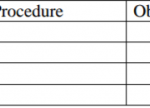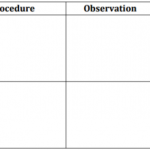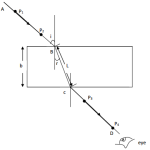KNEC KCSE Biology Paper 3 Question Paper / 2016 KCSE MOKASA Joint Examination
2016 KCSE MOKASA Joint Examination
Biology Paper 3
You are provided with a visking tubing. Open one end and blow air through the open end.
Tie firmly one end with a piece of thread provided. Make sure that it is not leaking.
Put into the tubing equal quantities of solution L1 and L2. Tie with a thread the open end
and ensure that the thread is long enough to suspend the visking tubing from the glass rod as
shown in the diagram.
Put the tubing suspended in distilled water as shown above. Let the set up stand for 30
minutes.
As you wait, carry out the food tests on solution L1 and L2 separately. Use only the reagents
provided and fill the table below. (6 marks)
a)
b) Remove some solution from the beaker after 20 minutes from the time you set the
experiment and test for the two food compounds you tested in (a) above
(2 marks)
c) Add 3 drops of iodine solution into the beaker. After 6 – 10 minutes, what do you observe in;
(i) The beaker (1 mark)
……………………………………………………………………………………………………………………………………
……………………………………………………………………………………………………………………………………
(ii) Visking tube (1 mark)
……………………………………………………………………………………………………………………………………
……………………………………………………………………………………………………………………………………
d) What physiological process is being tested in step (b) and (c) above (1 mark)
……………………………………………………………………………………………………………………………………
……………………………………………………………………………………………………………………………………
e) Account for your observations in steps (b) and (c) (3 marks)
……………………………………………………………………………………………………………………………………
……………………………………………………………………………………………………………………………………
……………………………………………………………………………………………………………………………………
……………………………………………………………………………………………………………………………………
14 marks
Below is a photograph of an organism. Examine it and answer the questions that follow.
a) The actual length of the pair of scissors next to the organism is 12.5cm. Using this information,
calculate actual length of the organism. (4 marks)
b) The photograph below shows structures visible after removing the parts labelled P. The inset is a
magnified view of one of the structures.
(i) Name the parts labelled R, S and T (3 marks)
R ………………………………………………………………………………………………………………………………
S ……………………………………………………………………………………………………………………………..
T ……………………………………………………………………………………………………………………………..
(ii) Explain how each of the parts named in (i) above is adapted to its function (3 marks)
R ……………………………………………………………………………………………………………………………….
……………………………………………………………………………………………………………………………………
S …………………………………………………………………………………………………………………………………
……………………………………………………………………………………………………………………………………
T ………………………………………………………………………………………………………………………………..
……………………………………………………………………………………………………………………………………
c) The photograph below shows the inner surface of the upper left side of the rib cage.
Explain the role of the part labelled M in inhalation (4 marks)
……………………………………………………………………………………………………………………………………
……………………………………………………………………………………………………………………………………
……………………………………………………………………………………………………………………………………
……………………………………………………………………………………………………………………………………
……………………………………………………………………………………………………………………………………
……………………………………………………………………………………………………………………………………
14 marks
(i) Identify the fruits labelled (5 marks)
S ……………………………………………………………………………………………………………………………..
L …………………………………………………………………………………………………………………………….
K ……………………………………………………………………………………………………………………………..
M ……………………………………………………………………………………………………………………………..
(ii) Give a reason for your identify of the specimen; (3 marks)
S ……………………………………………………………………………………………………………………………..
……………………………………………………………………………………………………………………………………
R ……………………………………………………………………………………………………………………………….
……………………………………………………………………………………………………………………………………
M ………………………………………………………………………………………………………………………………
……………………………………………………………………………………………………………………………………
(iii) Briefly describe any two types of placentations found in the fruits provided in 3(i) above
(2 marks)
……………………………………………………………………………………………………………………………………
……………………………………………………………………………………………………………………………………
……………………………………………………………………………………………………………………………………
……………………………………………………………………………………………………………………………………
(iv) State one difference between a seed and a fruit (1 mark)
……………………………………………………………………………………………………………………………………
……………………………………………………………………………………………………………………………………
(v) Using the handlens provided draw the fruit labelled R (3 marks)
14 marks








l requst to open for me another papers for easy of reversing